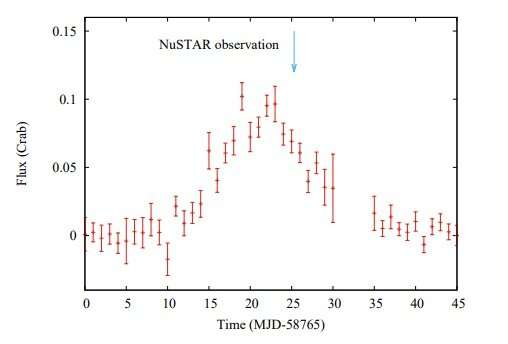February 1, 2021 report
New quasi-periodic oscillation detected from XTE J1858+034

Using NASA's NuSTAR and Swift space observatories, Indian astronomers have inspected an X-ray pulsar known as XTE J1858+034 during its outburst and identified a low-frequency quasi-periodic oscillation (QPO) from this source. The finding is reported in a paper published January 22 on the arXiv pre-print repository.
X-ray pulsars (also known as accretion-powered pulsars) are sources displaying strict periodic variations in X-ray intensity, consisting of a magnetized neutron star in orbit with a normal stellar companion. In these binary systems, the X-ray emission is powered by the release of gravitational potential energy as material is accreted from a massive companion. X-ray pulsars are among the most luminous objects in the X-ray sky.
XTE J1858+034 was first discovered in 1998 as a hard X-ray transient by the Rossi X-ray Timing Explorer (RXTE). Observations of this source have found that it is an X-ray pulsar with spin period of approximately 220.4 seconds and also detected that it experiences QPOs. Such oscillations are believed to occur when X-rays are emitted near the inner edge of an accretion disk in which gas swirls onto a compact object like a neutron star or a black hole.
Now, Manoj Mandal and Sabyasachi Pal of the Midnapore City College in Kuturia, India, report the detection of another QPO from XTE J1858+034, this time at low-frequency. The finding was based on the observations of this source during its recent outburst period that started in October 2019.
"We study the timing properties of XTE J1858+034 using the Nuclear Spectroscopic Telescope Array (NuSTAR) and Burst Alert Telescope onboard Swift during the outburst in October–November 2019. (...) During the recent outburst, the presence of low-frequency QPO is detected," the researchers wrote in the paper.
The observations detected a low-frequency QPO at 0.196 Hz with root mean square (RMS) variability of about 6.0 percent. It was found that the QPO frequency does not showcase any significant variation with energy. When it comes to the hardness ratio it also does not exhibit any significant variation over outburst.
Trying to explain the origin of the detected QPO of XTE J1858+034, Mandal and Pal suggest beat frequency and Keplerian frequency models. Given that in the case of this pulsar, regular pulsations and QPOs are found to be stronger in high energy, the authors of the paper favor the beat frequency model.
"The beat frequency model implies that QPOs are generated due to the beat phenomena between the spin of the neutron star and the rotation of the innermost part of the disk," the researchers explained.
The results allowed the scientists to more precisely calculate the spin period of XTE J1858+034. This parameter was found to be approximately 218.38 seconds.
More information: Detection of Low-Frequency QPO From X-ray Pulsar XTE J1858+034 During Outburst in 2019 with NuSTAR, arXiv:2101.09250 [astro-ph.HE] arxiv.org/abs/2101.09250
© 2021 Science X Network





















